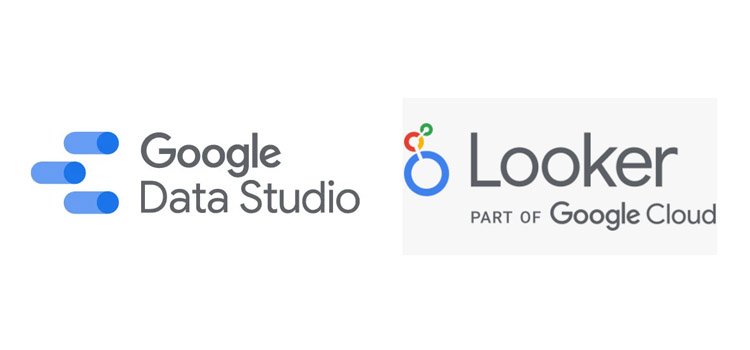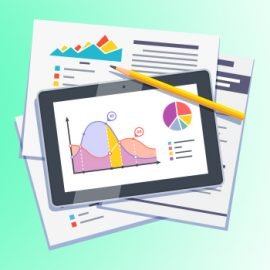
|
Getting your Trinity Audio player ready...
|
Google Data Studio was one of Google's coolest tools. It aimed to generate reports and data visualizations. In addition to being free, allowed connecting different data sources, creating custom visualizations. And also, with the collaboration of several users. But Google acquired Looker Studio in 2019 and has since integrated the platform with Google Cloud Platform (GCP), strengthening its data analytics capabilities and offering a comprehensive solution for companies seeking actionable insights from their data.
Continue reading this post and discover how Looker replaced Google Data Studio and what its benefits are!
What is Google Looker Studio
Google Looker Studio is a data analysis and visualization platform developed by Google. It allows companies to derive valuable insights from their data, transforming it into intuitive and interactive visualizations.
The platform offers a variety of features for data analysis, including the ability to connect to diverse data sources such as SQL databases, data lakes, and data warehouses. Therefore, with Looker Studio, users can create personalized dashboards and dynamic reports that help them better understand business performance, identify trends and make informed decisions.
Additionally, Google Looker Studio offers advanced data visualization capabilities, allowing users to create interactive charts, geographic maps, pivot tables, and more. What’s more, these visualizations can be customized according to the company’s specific needs and easily shared with colleagues and stakeholders.
Key Points of Google Looker Studio
The main features of the tool are:
- Connectivity to multiple data sources: Looker Studio lets you connect to a wide range of data sources, including SQL databases, data lakes, data warehouses, and cloud services like Google BigQuery, as well as Google tools like Google Analytics, Google Ads and Google Sheets.
- Flexible data modeling: Users can flexibly model data and create semantic models that reflect the structure and relationships of the organization's business data.
- Customizable views: Visualizations can be easily customized to meet specific business needs. Therefore, Google Looker Studio offers a variety of data visualization options, including interactive charts, pivot tables, geographic maps, and more.
- Intuitive data exploration: The platform offers an intuitive and easy-to-use interface for exploring data. Thus, it allows users to filter, segment and analyze data efficiently.
- Collaboration and sharing: Users can easily collaborate on analyzes and reports, sharing visualizations and insights with teammates and stakeholders.
- Advanced Security: Google Looker Studio offers advanced security features, including granular access control and integration with corporate authentication systems.
- Process automation: The platform supports process automation through scheduling data updates, automated alerts, and custom workflows.
- Integration with other Google Cloud Platform tools: The platform integrates seamlessly with other Google Cloud Platform tools such as BigQuery, Dataflow and Dataprep. As a result, it provides a complete solution for cloud data analysis.
These are just some of the key features of Google Looker Studio that make it a popular choice for businesses looking for actionable insights from their data.
How to use Looker Studio
The tool is very intuitive and easy to use. So, the first step is to define clear objectives regarding the data you need to analyze. This way, you'll know which metrics to include in the dashboard before you start customizing. Therefore, keep in mind that choosing the right kpis will have an impact on all the following steps:
-
Access to the Platform:
- Access the Google Looker Studio through your web browser.
- Log in to the platform with your user credentials.
-
Connect Data Sources:
- Connect your data sources to Looker Studio. This can include SQL databases, data lakes, data warehouses, and cloud services such as Google BigQuery.
- Configure the connections necessary to access the data you want to analyze.
-
Explore the Data:
- Use Looker Studio's intuitive interface to explore your data. Finally, browse the different available data sets and view the information you want to analyze.
-
Create Data Models:
- Create semantic data models that reflect the structure and relationships of your organization's business data. This allows you to do more advanced analysis and customize visualizations to your needs.
-
View the Data:
- Create custom data visualizations using a variety of options available in Looker Studio, such as interactive charts, pivot tables, and geographic maps.
- Customize views as needed to meet your specific needs.
-
Analyze and Interpret Data:
- Use Looker Studio's analytics tools to explore data in depth, filter and segment information as needed, and identify valuable insights.
-
Share Insights:
- Share your analysis and visualizations with teammates and stakeholders. Looker Studio offers options to share visualizations via links, embed them in other applications, or schedule automated reports.
-
Manage Access and Security:
- Manage access to data and analytics by configuring user permissions and granular access control.
- Ensure data is protected and in compliance with your organization's security policies.
The video below, prepared by Google, has an introduction to how to use the tool:
Tips for getting the most out of Google Looker Studio
Some tips to get the most out of Google Looker Studio:
1. Understand your Data Structure:
Before you start creating data models and visualizations, make sure you fully understand the structure of your data. This way, you will be able to create more accurate and relevant semantic models.
2. Explore Data Modeling Resources:
Familiarize yourself with Looker Studio's data modeling features such as scaling, pivoting, and filtering. This way, you can model your data effectively and create more meaningful visualizations.
3. Use Interactive Visualizations:
Explore the interactive visualization options offered by Looker Studio, such as line, bar, and pie charts. This way, you'll have visualizations that can help you communicate your insights more effectively.
4. Leverage Analytics Features:
Use Looker Studio's analytics tools like filters, segmentations, and custom metrics to explore your data in depth and identify valuable insights.
5. Customize your Views:
Customize your visualizations according to your target audience and analysis objective. Consequently, you can include adding clear titles, informative captions, and meaningful colors.
6. Collaborate with your Team:
Use Looker Studio's collaboration features to share your analysis and visualizations with teammates and stakeholders. As a result, it will foster a culture of collaboration and data-driven decision-making.
7. Apply Report Scheduling:
Set up schedules for automated reporting, ensuring relevant information is delivered to stakeholders in a timely and consistent manner.
8. Stay Updated:
Always stay tuned for updates and new features in Looker Studio. Eventually, Google is constantly adding improvements and features to the platform, so make the most of these updates to improve your data analysis experience.
9. Participate in Trainings and Communities:
Take advantage of the training resources offered by Google Looker Studio and participate in online communities where you can share knowledge, get support and exchange experiences with other users of the platform.
By following these tips, you will be able to get more out of Google Looker Studio and transform your data into valuable insights for your business.
Did you like this post? How about signing up to receive our content? Or, if you prefer, contact a Vero expert. This way, it can help your company with data analysis.

Marcel Castilho is a specialist in digital marketing, neuromarketing, neuroscience, mindfulness and positive psychology. In addition to being an advertiser, he also has a Master's degree in Neurolinguistic Programming. He is the founder and owner of Vero Comunicação and also the digital agency Vero Contents.



